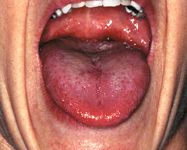- Acne
- Actinic Keratosis
- Aesthetics
- Alopecia
- Atopic Dermatitis
- Buy-and-Bill
- COVID-19
- Case-Based Roundtable
- Chronic Hand Eczema
- Chronic Spontaneous Urticaria
- Drug Watch
- Eczema
- General Dermatology
- Hidradenitis Suppurativa
- Melasma
- NP and PA
- Pediatric Dermatology
- Pigmentary Disorders
- Practice Management
- Precision Medicine and Biologics
- Prurigo Nodularis
- Psoriasis
- Psoriatic Arthritis
- Rare Disease
- Rosacea
- Skin Cancer
- Vitiligo
- Wound Care
Article
For oral diseas tx, manage dry mouth
New Orleans — Xerostomia can complicate the diagnosis and management of various oral diseases and is an important condition to recognize and treat, said Susan L. Zunt, D.D.S., M.S., at the 63rd Annual Meeting of the American Academy of Dermatology, here.
New Orleans - Xerostomia can complicate the diagnosis and management of various oral diseases and is an important condition to recognize and treat, said Susan L. Zunt, D.D.S., M.S., at the 63rd Annual Meeting of the American Academy of Dermatology, here.

She adds that while artificial saliva substitutes may be a more familiar management technique, pharmacologic restoration of salivary flow with prescription medications provides a better, more comfortable option for patients. She explains that in patients who present with burning mouth syndrome, xerostomia needs to be included in the differential diagnosis.

Making the diagnosis The presence of xerostomia may be suggested by history and examination of the oral cavity. However, accurate diagnosis of salivary gland hypofunction requires sialometry - a simple, in-office test that measures saliva flow rate over a five-minute period.
"Sialometry should be performed if there is no pool of saliva in the floor of the mouth. However, it is important to be aware that patients with an oral infection or erosive lesions might have stimulated flow and they should be tested or retested after the mouth is healed," Dr. Zunt says.
Unstimulated sialometry is performed when the patient has been fasting for at least an hour. Patients identified as having abnormally low salivary flow are then tested with stimulated sialometry to determine if there is functional salivary gland tissue present, indicating the patient may be a candidate for treatment with salivary gland stimulating medications.
In the unstimulated test, Dr. Zunt uses a result of 0.1 ml/min to diagnose salivary gland hypofunction. However, a value of 0.2 ml/min is also recommended in the literature.
"Both of these measures are indicative of a very low amount of saliva flow, but I prefer using the more stringent 0.1 ml/min rate so that I can be more certain the patient has salivary gland hypofunction. However, there are times when I will go on to salivary stimulation testing in patients with a higher flow rate if they also have marked signs and symptoms of xerostomia, such as oral discomfort, high dental caries rate or frequent oral yeast infections," she says.
The stimulated salivary flow rate test is performed by applying citric acid to the tongue, chewing unflavored paraffin, or after a test dose of secretagogue. Patients in whom saliva production increases are considered candidates for salivary stimulant treatment. However, even patients who have advanced destruction of salivary gland tissue, such as secondary to previous head and neck radiation therapy or in association with various autoimmune diseases, and who do not show any response in the stimulated testing may still be given a trial with a salivary stimulant.
"Since the sialometry is performed over such a short period of time, I am willing to start some patients on a three-month trial and see if they benefit based on assessment of clinical endpoints, such as improvement in problems with oral infections, dental decay, comfort, and ease of swallowing and speech," she says.
Newsletter
Like what you’re reading? Subscribe to Dermatology Times for weekly updates on therapies, innovations, and real-world practice tips.











